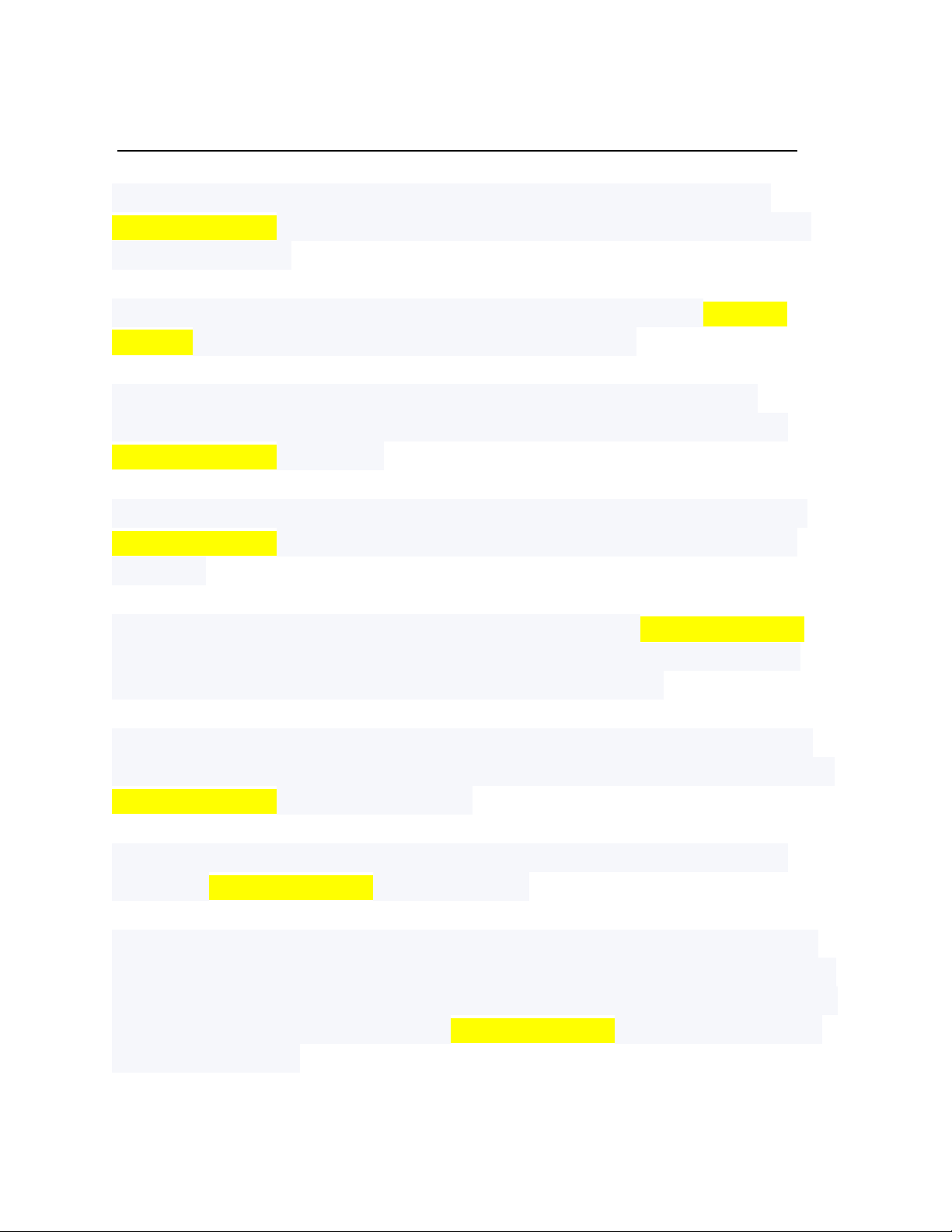
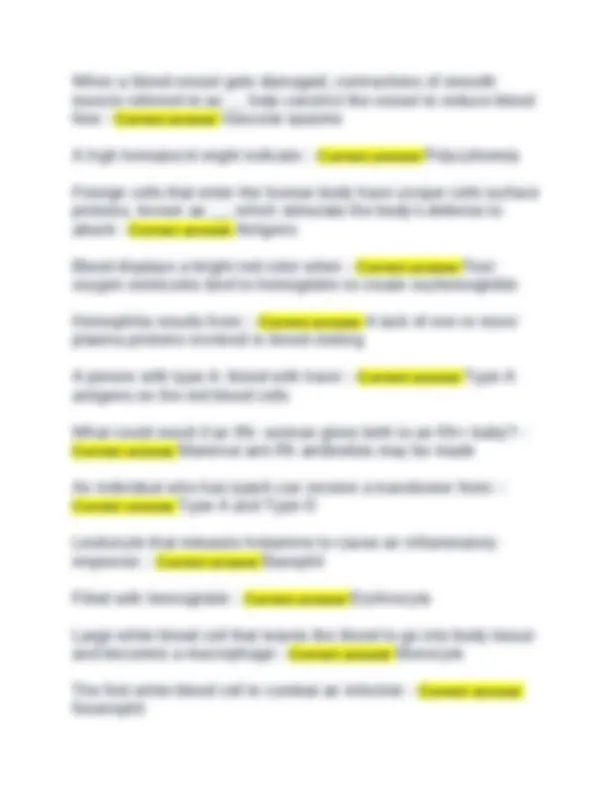
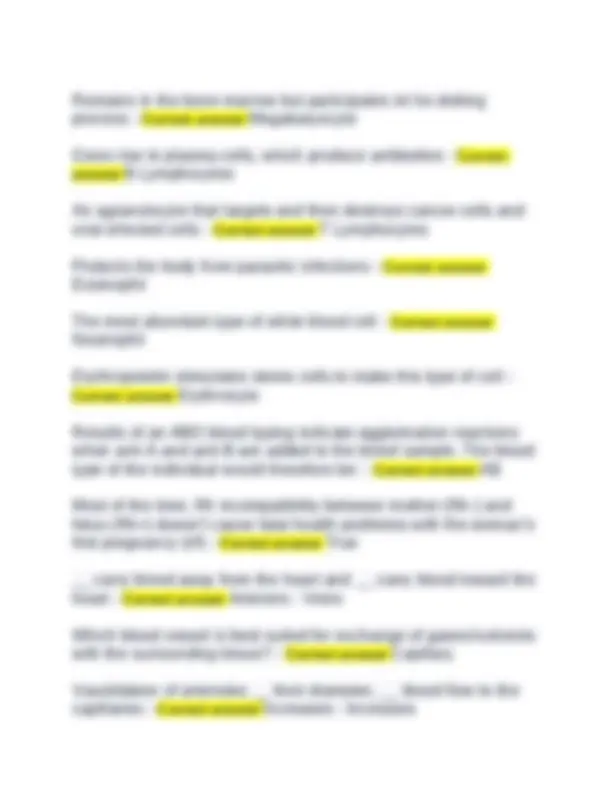
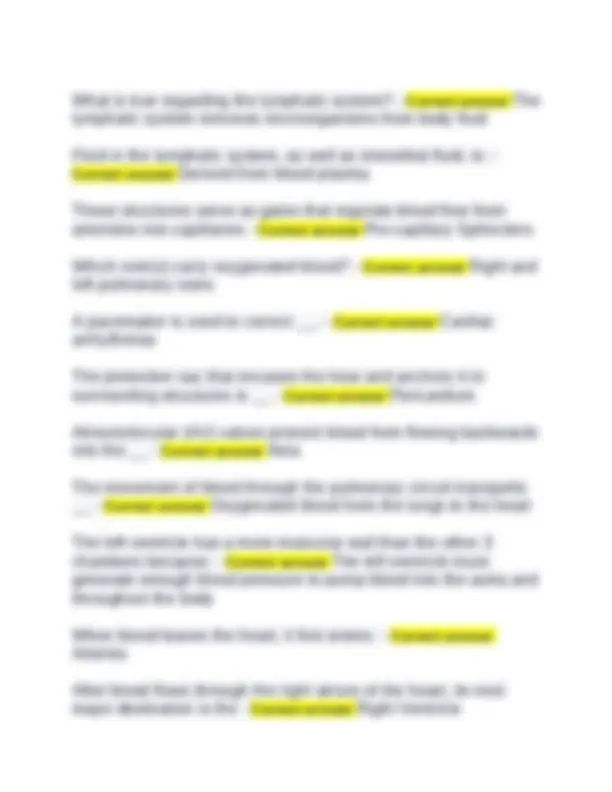
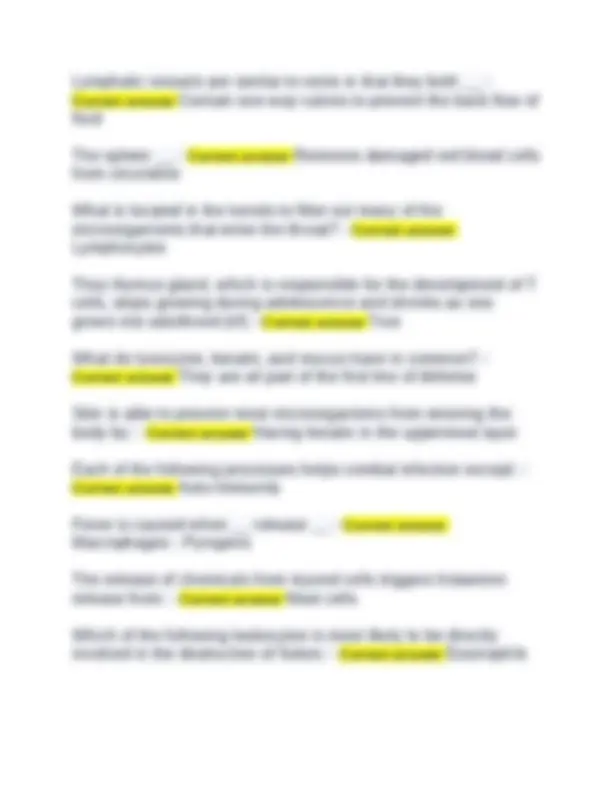
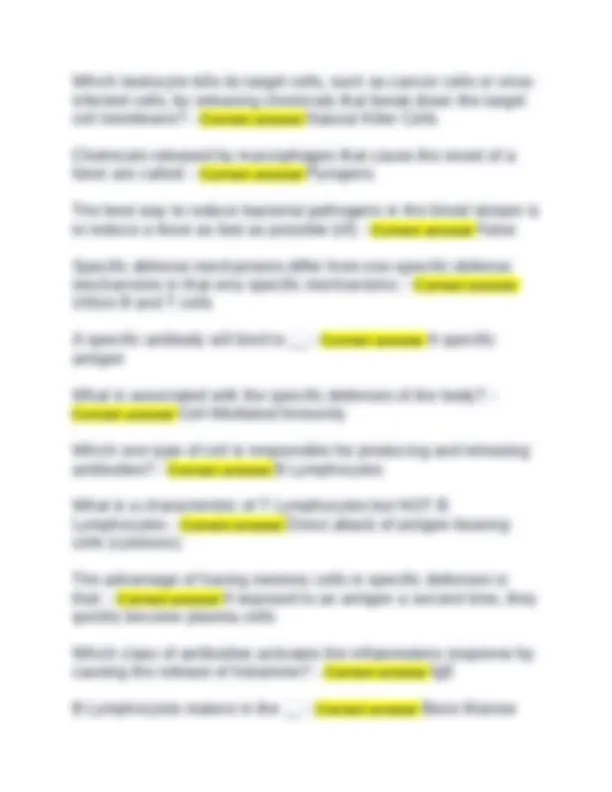
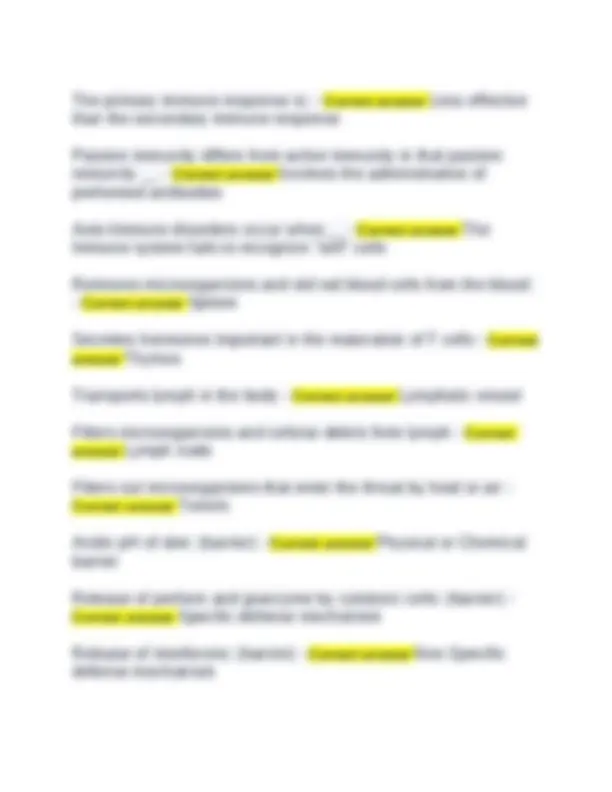
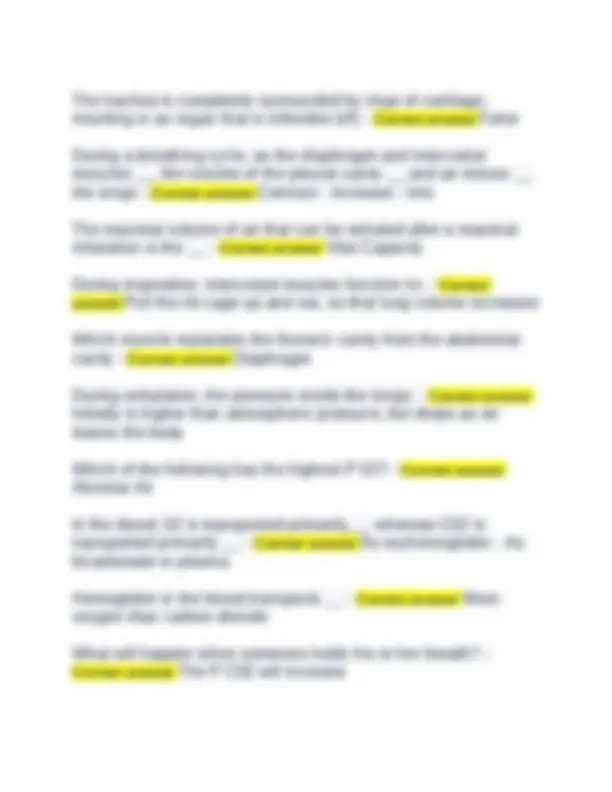
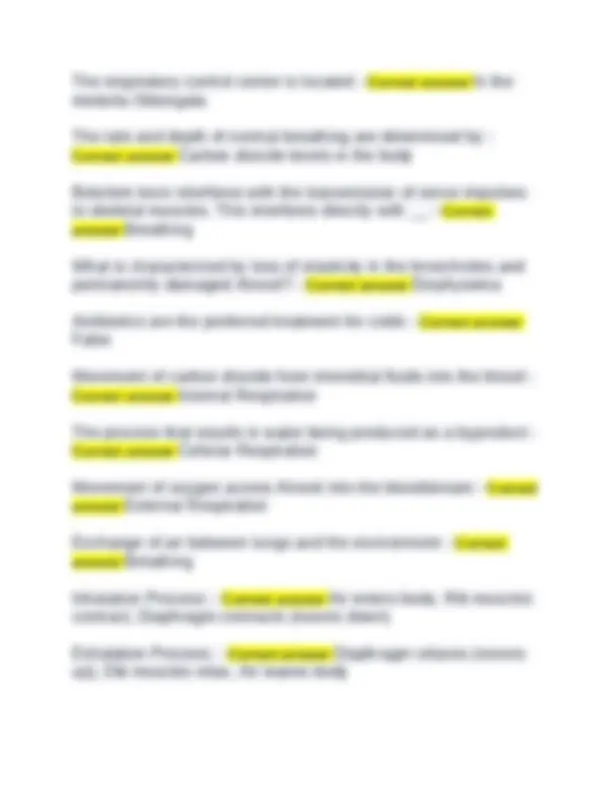
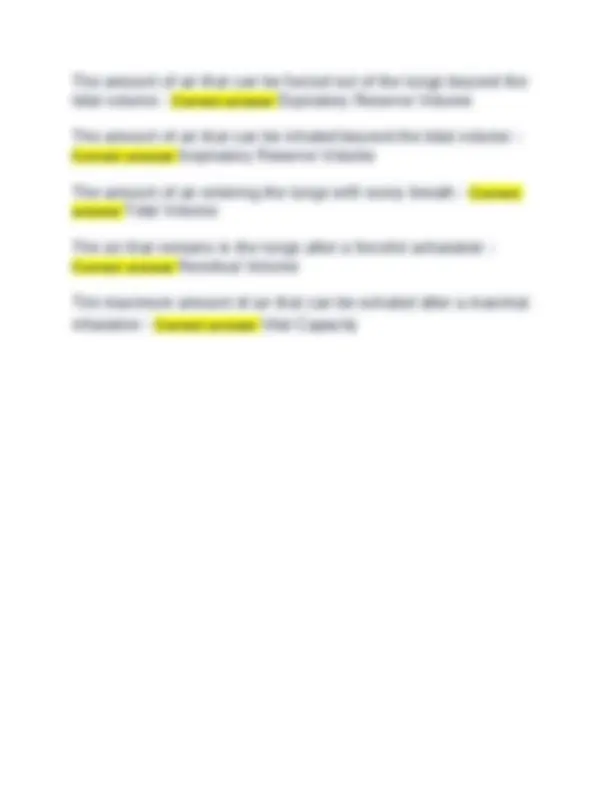


Study with the several resources on Docsity

Earn points by helping other students or get them with a premium plan


Prepare for your exams
Study with the several resources on Docsity

Earn points to download
Earn points by helping other students or get them with a premium plan
Community
Ask the community for help and clear up your study doubts
Discover the best universities in your country according to Docsity users
Free resources
Download our free guides on studying techniques, anxiety management strategies, and thesis advice from Docsity tutors
BSC 109 - Exam 2 Questions and Answers. BSC 109 - Exam 2 Questions and Answers.
Typology: Exams
1 / 15

This page cannot be seen from the preview
Don't miss anything!










When discussing blood plasma, we can correctly say that: - Correct answer Plasma contains albumins that need to maintain osmotic balance What is the last step in the formation of blood clots? - Correct answer Clotting proteins form an insoluble mesh Name the specific type of granular leukocyte that releases histamines that are important in the inflammatory response. - Correct answer Basophils What can we say about the origin and structures of platelets? - Correct answer Platelets are cell fragments derived from mega karyotes How can we accurately describe hemoglobin? - Correct answer Hemoglobin is the four-stranded protein molecule found in red blood cells that carry oxygen to the individual cells Which of the following blood components protect that individual from a variety of infectious agents such as bacteria and viruses? - Correct answer White Blood Cells Which of the following make up the greatest volume of whole blood? - Correct answer Plasma (55%) Jason has just spent 4 weeks in Rocky Mountain National Park, studying plants that grow above 10,000 feet in elevation. Which of the following would be a likely change in his blood because of the time spent at high elevation? - Correct answer Increased number of red blood cells
Which white blood cells are present in the greatest number in the blood and are the body's first responders to infection? - Correct answer Neutrophils What property do red blood cells and platelets have in common? - Correct answer Both lack a nucleus The iron atom of a heme group within hemoglobin functions to: - Correct answer Bind oxygen Red blood cells are accurately described as - Correct answer Small and flat Erythropoietin stimulates production of __ in response to __ - Correct answer Red blood cells - Low oxygen availability Histamine is released from which of the following types of leukocyte to stimulate inflammatory response? - Correct answer Basophil Which population of cells is most increased during bacterial infections? - Correct answer Neutrophils A damaged red blood cell is removed from circulation by - Correct answer Phagocytosis by macrophages in the spleen What is true regarding deoxyhemoglobin? - Correct answer Deoxyhemoglobin is found in blood returning to the heart from the lower extremities A researcher wants to produce antibodies by growing cells in the lab. What cell population would be necessary to accomplish this?
Remains in the bone marrow but participates int he dotting process - Correct answer Megakaryocyte Gives rise to plasma cells, which produce antibodies - Correct answer B Lymphocytes An agranulocyte that targets and then destroys cancer cells and viral-infected cells - Correct answer T Lymphocytes Protects the body from parasitic infections - Correct answer Eosinophil The most abundant type of white blood cell - Correct answer Neutrophil Erythropoietin stimulates stems cells to make this type of cell - Correct answer Erythrocyte Results of an ABO blood typing indicate agglutination reactions when anti-A and anti-B are added to the blood sample. The blood type of the individual would therefore be: - Correct answer AB Most of the time, Rh incompatibility between mother (Rh-) and fetus (Rh+) doesn't cause fatal health problems with the woman's first pregnancy (t/f) - Correct answer True __ carry blood away from the heart and __ carry blood toward the heart - Correct answer Arteriers - Veins Which blood vessel is best suited for exchange of gases/nutrients with the surrounding tissue? - Correct answer Capillary Vasolidation of arterioles __ their diameter, __ blood flow to the capillaries - Correct answer Increases - Increases
What is true regarding the lymphatic system? - Correct answer The lymphatic system removes microorganisms from body fluid Fluid in the lymphatic system, as well as interstitial fluid, is: - Correct answer Derived from blood plasma These structures serve as gates that regulate blood flow from arterioles into capillaries - Correct answer Pre-capillary Sphincters Which vein(s) carry oxygenated blood? - Correct answer Right and left pulmonary veins A pacemaker is used to correct __. - Correct answer Cardiac arrhythmias The protective sac that encases the hear and anchors it to surrounding structures is __ - Correct answer Pericardium Atrioventricular (AV) valves prevent blood from flowing backwards into the __ - Correct answer Atria The movement of blood through the pulmonary circuit transports __ - Correct answer Oxygenated blood from the lungs to the heart The left ventricle has a more muscular wall than the other 3 chambers because: - Correct answer The left ventricle must generate enough blood pressure to pump blood into the aorta and throughout the body When blood leaves the heart, it first enters: - Correct answer Arteries After blood flows through the right atrium of the heart, its next major destination is the - Correct answer Right Ventricle
This blood vessel transports blood from the heart to capillaries - Correct answer Artery The inner walls are lined with endothelium to create a smooth, low-friction surface: - Correct answer Artery/Vein This blood vessel permits exchange of nutrients and gases between blood and tissues - Correct answer Capillary Medium- and large-size vessels maintain a partial state of muscle contraction, resulting in high intravessel pressure - Correct answer Artery Which of the following statements is true about veins? - Correct answer Viruses require a host cell in which to reproduce In which of the following ways are bacterial cells similar to human cells? - Correct answer Bacterial cells use ATP to fuel cellular respiration What pathogenic agents cause a self-propagating misfolding of proteins in nerve cells? - Correct answer Prions Living, and some non-living, entities that cause disease are called? - Correct answer Pathogens Characteristics of bacteria include all of the following except: - Correct answer Presence of membrane-bound organelles What is true when comparing viruses and bacteria? - Correct answer Viruses and bacteria both contain genetic mutations Bacterial infections are generally treated with __ - Correct answer Antibiotics
Lymphatic vessels are similar to veins in that they both __ - Correct answer Contain one-way valves to prevent the back flow of fluid The spleen __ - Correct answer Removes damaged red blood cells from circulation What is located in the tonsils to filter out many of the microorganisms that enter the throat? - Correct answer Lymphocytes They thymus gland, which is responsible for the development of T cells, stops growing during adolescence and shrinks as one grows into adulthood (t/f) - Correct answer True What do lysozyme, keratin, and mucus have in common? - Correct answer They are all part of the first line of defense Skin is able to prevent most microorganisms from entering the body by: - Correct answer Having keratin in the uppermost layer Each of the following processes helps combat infection except: - Correct answer Auto-Immunity Fever is caused when __ release __ - Correct answer Macrophages - Pyrogens The release of chemicals from injured cells triggers histamine release from: - Correct answer Mast cells Which of the following leukocytes is most likely to be directly involved in the destruction of flukes: - Correct answer Eosinophils
The primary immune response is: - Correct answer Less effective than the secondary immune response Passive immunity differs from active immunity in that passive immunity __ - Correct answer Involves the administration of preformed antibodies Auto-Immune disorders occur when__ - Correct answer The Immune system fails to recognize "self" cells Removes microorganisms and old red blood cells from the blood:
Natural Killer Cells: (barrier) - Correct answer Non-Specific defense mechanism Inflammation: (barrier) - Correct answer Non-Specific defense mechanism Cytotoxic T Cells: (barrier) - Correct answer Specific defense mechanism Earwax: (barrier) - Correct answer Physical or chemical barrier Production of antibodies by plasma cells: (barrier) - Correct answer Specific defense mechanism The exchange of gases between inhaled air and the blood is called__ - Correct answer External Respiration Ventilation refers to the process by which: - Correct answer Air moves into and out of the lungs What system is not involved in the process of breathing? - Correct answer Circulatory system How does external respiration differ from internal respiration? - Correct answer External respiration refers to gas exchange between inhaled air and blood, whereas internal respiration refers to gas exchange between the blood and tissue fluids Oxygen moves from lungs into the blood during internal respiration? (t/f) - Correct answer False List the order of structures through which air will pass during inspiration? - Correct answer Nose Pharynx Larynx
The trachea is completely surrounded by rings of cartilage, resulting in an organ that is inflexible (t/f) - Correct answer False During a breathing cycle, as the diaphragm and intercostal muscles , the volume of the pleural cavity __ and air moves __ the lungs - Correct answer Contract - Increase - Into The maximal volume of air that can be exhaled after a maximal inhalation is the __ - Correct answer Vital Capacity During inspiration, intercostal muscles function to: - Correct answer Pull the rib cage up and out, so that lung volume increases Which muscle separates the thoracic cavity from the abdominal cavity - Correct answer Diaphragm During exhalation, the pressure inside the lungs: - Correct answer Initially is higher than atmospheric pressure, but drops as air leaves the body Which of the following has the highest P 02? - Correct answer Alveolar Air In the blood, 02 is transported primarily, whereas C02 is transported primarily __ - Correct answer As oxyhemoglobin - As bicarbonate in plasma Hemoglobin in the blood transports __ - Correct answer More oxygen than carbon dioxide What will happen when someone holds his or her breath? - Correct answer The P C02 will increase
The respiratory control center is located - Correct answer In the medulla Oblongata The rate and depth of normal breathing are determined by - Correct answer Carbon dioxide levels in the body Botulism toxin interferes with the transmission of nerve impulses to skeletal muscles. This interferes directly with __ - Correct answer Breathing What is characterized by loss of elasticity in the bronchioles and permanently damaged Alveoli? - Correct answer Emphysema Antibiotics are the preferred treatment for colds - Correct answer False Movement of carbon dioxide from interstitial fluids into the blood - Correct answer Internal Respiration The process that results in water being produced as a byproduct - Correct answer Cellular Respiration Movement of oxygen across Alveoli into the bloodstream - Correct answer External Respiration Exchange of air between lungs and the environment - Correct answer Breathing Inhalation Process: - Correct answer Air enters body, Rib muscles contract, Diaphragm contracts (moves down) Exhalation Process: - Correct answer Diaphragm relaxes (moves up), Dib muscles relax, Air leaves body